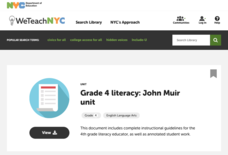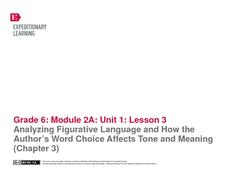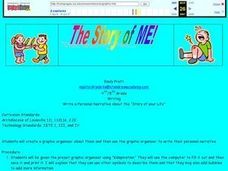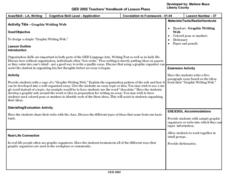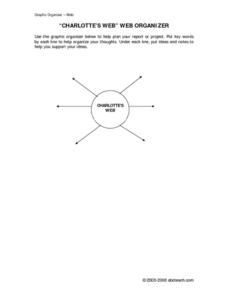Roald Dahl
James and the Giant Peach Lesson Plans
Immerse yourself in the world of giant bugs, rolling peaches, and brave little boys with an interdisciplinary unit on James and the Giant Peach. Young readers focus on the scientific themes of Roald Dahl's classic novel with bug hunts,...
New York City Department of Education
Grade 4 Literacy: John Muir Unit
Learn how to correctly analyze and score a written performance task. Example work shows annotated think alouds for grading. Teachers also have access to graphic organizers for helping writers succeed,
McGraw Hill
Study Guide for Frankenstein
Help the class uncover the story of Frankenstein. Learners answer questions and complete activities to respond to the text Frankenstein as they read. Scholars learn new vocabulary, respond to personal and text-dependent questions,...
Curated OER
Lesson: Paul Chan: Alternumeric Fonts
Learning to analyze language, symbols, and codes is part of becoming a deep and critical thinker. Young analysts consider their ability to see hidden messages as they analyze the work of Paul Chan. There are two fully developed...
EngageNY
Analyzing Figurative Language and How the Author’s Word Choice Affects Tone and Meaning (Chapter 3)
How figurative language affects the tone and meaning in Chapter Three of Christopher Paul Curtis' Bud, Not Buddy is the focus of a series of exercises that ask readers to locate, record, and analyze Curtis' word choices.
EngageNY
Figurative Language and Word Choice: A Closer Look at Bud, Not Buddy (Chapter 2)
The difference between an average and an unforgettable writing can lie in the author's word choice. The figurative language in Chapter 2 of Christopher Paul Curtis's Newbery Medal Winner, Bud, Not Buddy, is the focus of a series of...
EngageNY
Getting the Gist and Determining Word Meaning: Paragraphs 12–14 of Steve Jobs’ Commencement Address (and connecting to Chapter 8)
Groups use a Venn diagram to compare the theme of love and loss in Steve Jobs' 2005 commencement address to Stanford University students and Christopher Paul Curtis' Bud, Not Buddy.
EngageNY
Grade 9 ELA Module 2, Unit 3, Lesson 5
After rereading the full text of Walter Mosley's essay "True Crime," groups complete an evidence collection tool worksheet, and then class members independently draft a multi-paragraph, evidence-based response that identifies how Mosley...
Curated OER
The Story of Me
Students are given the preset graphic organizer using "Kidspiration". They create a graphic organizer about them and then use the graphic organizer to write their personal narrative.
Curated OER
Snapshots of a Short Story
First graders will be creating and filling in a graphic organizer using Kidspiration, as a pre-writing activity for their short story piece. They then use their graphic organizers to write their entire short story. Once written, the...
Curated OER
Story Mapping
Help your learners map a story with a graphic organizer provided. Four squares for setting, problem, characters, and solution surround the circle for theme. Use this with any story you may be reading to go over important...
Curated OER
Using Graphic Organizers to Generate Genre Definitions
Students listen to or read a variety of stories and then work individually or in groups to complete graphic organizers that will help them focus on elements within different types of stories. They write definitions for a variety of story...
Curated OER
Dish: From A to Z
Learners are read several ABC books and choose a different letter to illustrate for a class book. They use clip art to find his/her letter and insert it at the top of the page centered and find 4 pictures that begin with the same letter.
Curated OER
Graphic Writing Web
Students discuss and develop graphic writing webs, writing supporting ideas for a given topic.
Curated OER
Practice Exercises in IT Skills Pack 4: Presentation Graphics
Learners explore how to annotate and align clip art as well as create Powerpoint presentations. In this presentation graphics lesson, students expand their IT skills set by completing 4 projects employing clip art and presentation software.
Curated OER
A Graphic Scene
Third graders discuss the advantages of using various graphic organizers including Venn Diagrams and T-charts. They use the organizers to compare and contrast different versions of classic mythological stories.
Curated OER
From Graphic Organizer to Comparison
Fifth graders brainstorm a variety of topics for writing. As a class, learners create four types of graphic organizers on selected topics. They discuss how to use graphic organizer in constructing a written paragraph.
Curated OER
Comparing and Contrasting Fiction and Nonfiction Using Graphic Organizers
Students compare and contrast fiction and non-fiction selections. In this writing skills lesson plan, students use different forms of graphic organizers to compare "The Three Little Pigs," to Wiesel's Night.
Curated OER
Food Spider Map: Graphic Organizer
In this food spider map worksheet, students utilize a food spider map graphic organizer to plan their report or project about food. Students list eight facts about food on the lines provided.
Curated OER
Cause and Effect Graphic Organizer
In this graphic organizer worksheet, students fill in a ladder type graphic organizer with the causes and effects in a story. They fill in 6 sets of causes and effects.
Curated OER
Art and Technology - Design - Alexander Calder
Students gain an awareness for the work of Alexander Calder, study a variety of utilitarian objects and discuss their purposes, and create graphic of a utilitarian piece using computer graphic software.
Curated OER
Graphic Organizer-- Spider Map
In this graphic organizer worksheet students may use this helpful tool to organize facts on any subject. The spider map refers to the way this looks with a center main topic and specific facts coming out on the "legs".
Curated OER
Web Graphic Organizer for Charlotte's Web
In this literature worksheet, students use the web shaped graphic organizer to record details about the book Charlotte's Web.
Curated OER
Self-Portrait With Literal Reference
Students create self-portraits using ideas from a particular theme and piece of literature in this high school Art lesson. Emphasis is placed on combining visual and literal material in a cohesive manner.
Other popular searches
- Art Graphic Design
- Graphic Artists
- Graphic Design Art Lessons
- Graphic Art Logos
- Digital Graphic Arts
- Graphic Art Safety
- Graphic Art Photoshop
- Graphic Arts Communication
- Graphic Arts Vocabulary
- Graphic Art Word Search
- Graphic Art Design
- Graphic Art Votech



